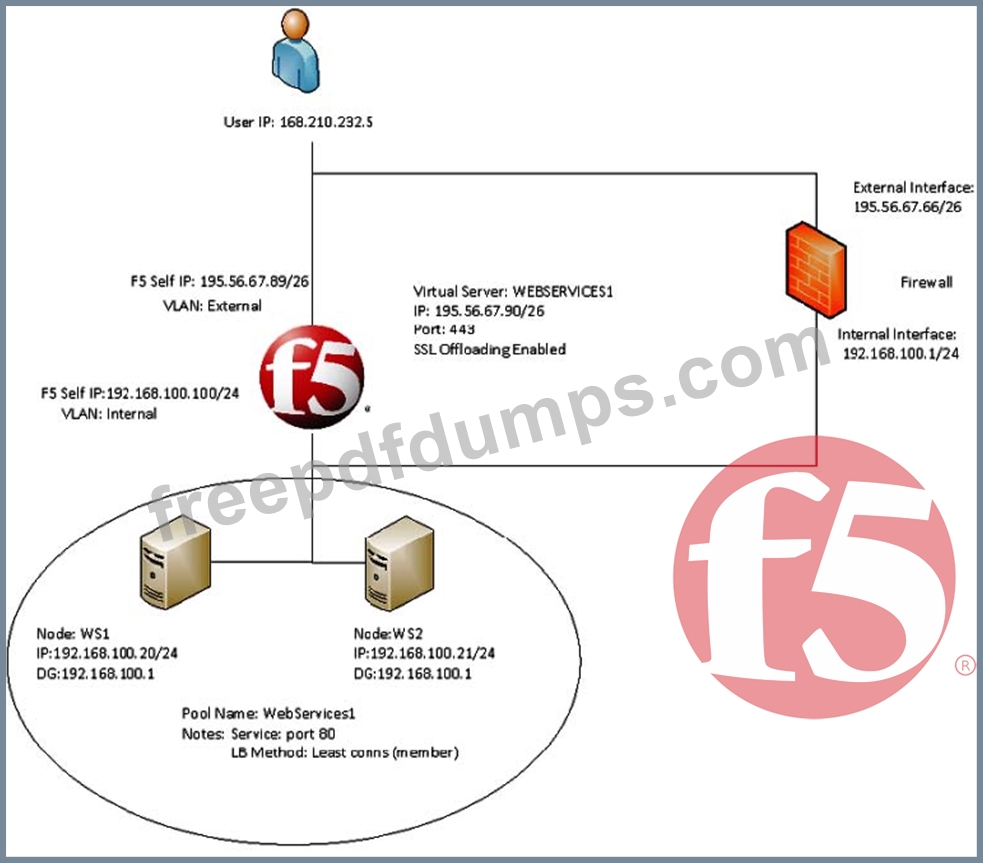301b Exam Question 66
-- Exhibit -

-- Exhibit -
Refer to the exhibit.
A company uses a complex piece of client software that connects to one or more virtual servers (VS) hosted on an LTM device. The client software is experiencing issues. An LTM Specialist must determine the cause of the problem.
The LTM Specialist is seeing a client source IP of 168.210.232.5 in the tcpdump. However, the client source IP is actually 10.123.17.12.
Why does the IP address of 10.123.17.12 fail to appear in the tcpdump?

-- Exhibit -
Refer to the exhibit.
A company uses a complex piece of client software that connects to one or more virtual servers (VS) hosted on an LTM device. The client software is experiencing issues. An LTM Specialist must determine the cause of the problem.
The LTM Specialist is seeing a client source IP of 168.210.232.5 in the tcpdump. However, the client source IP is actually 10.123.17.12.
Why does the IP address of 10.123.17.12 fail to appear in the tcpdump?
301b Exam Question 67
An LTM Specialist has configured a virtual server for www.example.com, load balancing connections to a pool of application servers that provide a shopping cart application. Cookie persistence is enabled on the virtual server. Users are able to connect to the application, but the user's shopping cart fails to update. A traffic capture shows the following:
Request:
GET /cart/updatecart.php HTTP/1.1
Host: www.example.com
Connection: keep-alive
Cache-Control: max-age=0
User-Agent: Mozilla/5.0 (Macintosh; Intel Mac OS X 10_7_5) AppleWebKit/537.4 (KHTML, like Gecko) Chrome/22.0.1229.94 Safari/537.4 Accept: text/html,application/xhtml+xml,application/xml;q=0.9,*/*;q=0.8 Accept-EncodinG. gzip,deflate,sdch Accept-LanguagE. en-US,en;q=0.8 Accept-Charset: ISO-8859-1,utf-8;q=0.7,*;q=0.3 CookiE. BIGipServerwebstore_pool=353636524.20480.0000 Response:
HTTP/1.1 200 OK
DatE. Wed, 24 Oct 2012 18:00:13 GMT
Server: Apache/2.2.22 (Ubuntu)
X-Powered-By: PHP/5.3.10-1ubuntu3.1
Set-CookiE. cartID=647A5EA6657828C69DB8188981CB5; path=/; domain=wb01.example.com Keep-AlivE. timeout=5, max=100 Connection: Keep-Alive Content-TypE. text/html No changes can be made to the application.
What should the LTM Specialist do to resolve the problem?
Request:
GET /cart/updatecart.php HTTP/1.1
Host: www.example.com
Connection: keep-alive
Cache-Control: max-age=0
User-Agent: Mozilla/5.0 (Macintosh; Intel Mac OS X 10_7_5) AppleWebKit/537.4 (KHTML, like Gecko) Chrome/22.0.1229.94 Safari/537.4 Accept: text/html,application/xhtml+xml,application/xml;q=0.9,*/*;q=0.8 Accept-EncodinG. gzip,deflate,sdch Accept-LanguagE. en-US,en;q=0.8 Accept-Charset: ISO-8859-1,utf-8;q=0.7,*;q=0.3 CookiE. BIGipServerwebstore_pool=353636524.20480.0000 Response:
HTTP/1.1 200 OK
DatE. Wed, 24 Oct 2012 18:00:13 GMT
Server: Apache/2.2.22 (Ubuntu)
X-Powered-By: PHP/5.3.10-1ubuntu3.1
Set-CookiE. cartID=647A5EA6657828C69DB8188981CB5; path=/; domain=wb01.example.com Keep-AlivE. timeout=5, max=100 Connection: Keep-Alive Content-TypE. text/html No changes can be made to the application.
What should the LTM Specialist do to resolve the problem?
301b Exam Question 68
An LTM device is serving an FTP virtual server that has three pool members. The FTP pool members are monitored via TCP port 21. Customers are reporting that they are able to log in, but are sometimes unable to upload files to the server.
Which monitor should the LTM Specialist configure to verify that the servers can handle file uploads?
Which monitor should the LTM Specialist configure to verify that the servers can handle file uploads?
301b Exam Question 69
A device on the network is configured with the same IP address as the management address of the active LTM device, causing the management GUI to be inaccessible.
Which two methods should the LTM Specialist use to access the LTM device in order to change the management IP address? (Choose two.)
Which two methods should the LTM Specialist use to access the LTM device in order to change the management IP address? (Choose two.)
301b Exam Question 70
Given the iRule:
when HTTP_REQUEST {
if {([HTTP::username] ne "") and ([HTTP::password] ne "") } {
log local0. "client ip [IP::remote_addr] credentials provided [HTTP::username] [HTTP::password]"} else { pool old_application_pool
}
}
The associated virtual server has a default pool named new_application_pool.
Which functionality does the iRule provide?
when HTTP_REQUEST {
if {([HTTP::username] ne "") and ([HTTP::password] ne "") } {
log local0. "client ip [IP::remote_addr] credentials provided [HTTP::username] [HTTP::password]"} else { pool old_application_pool
}
}
The associated virtual server has a default pool named new_application_pool.
Which functionality does the iRule provide?

